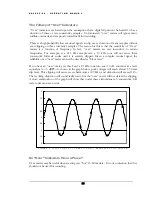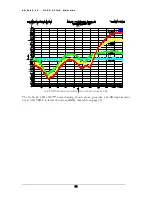
A D 2 4 0 2 - 9 6 - O P E R A T I N G M A N U A L
Chapter
6
Design Philosophy
Our Goals and Design Methodology
he AD2402-96R was designed by John Siau, Allen H. Burdick, and Ralph Henry at
Benchmark Media Systems, Inc. It is carefully engineered to reliably provide the highest
possible audio transparency. We have not tried to add “warmth” or “color” to the audio.
Instead, we have attempted to produce a piece of equipment that sounds as close to a
piece of wire as possible.
T
Converters are often viewed as digital products, and are most often designed by digital hardware
and software engineers without adequate attention to the analog sections. The importance of the
analog circuitry is often overlooked, and the resulting defects easily go undetected.
Unfortunately, given time, our ears usually detect these defects.
Our ears have a dynamic range of about 130 dB, and we can hear tones 20 to 30 dB below white
noise. The presence of noise may allow audible defects to escape the scrutiny of many bench
tests. We can hear multiple tones at various amplitudes simultaneously. Many audio
measurements are only capable of measuring the tone having the highest amplitude. Again,
bench tests can ignore critical information!
Because bench tests have often failed to detect audio defects, some have discounted their value
and have relied solely on listening tests. We believe listening tests are a valuable tool for
evaluating a finished product and for confirming the validity of a careful and thorough bench
testing/development cycle. The key is;
we must employ test techniques that expose all audio defects
. Then
these defects can be eliminated or reduced long before they could be detected through listening
tests and/or field use.
Our experience shows that a careful and thorough bench testing/development program enables
us to produce products that sound right the first time. It is important to note that specifications
can be very misleading. Each spec by itself only paints a small picture of the total performance
that can be expected. It is quite possible to select certain tests, test signals, frequencies, levels, and
parameters that make a given product look good on a spec sheet. It is also our view that
specifications should never be selected for marketing purposes. Product specifications should be
comprehensive, and should include graphs and FFT plots. Bench testing must be viewed as a
product development tool, and not as a marketing tool.
27
















































